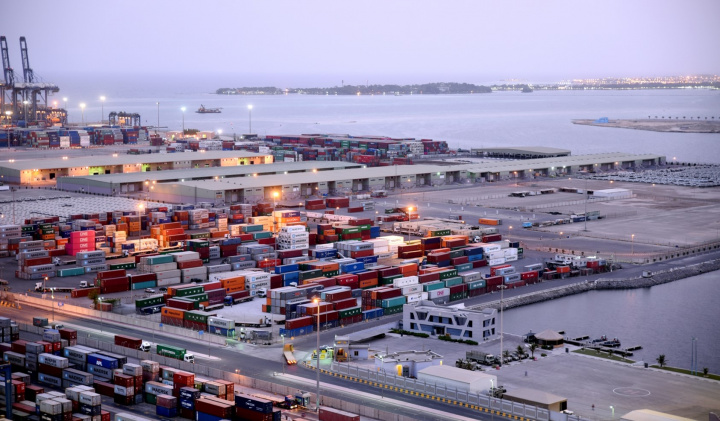Concern is growing for the lives of sailors, as the campaign of attacks on shipping in the Red Sea by the Houthi rebels shows no signs of ending.
Despite counterstrikes by the US and British navies, the Yemeni rebels have sustained attacks against commercial ships, using drones and missiles, as part of their pressure campaign over Israel’s war in Gaza.
On Friday, Houthi forces in Yemen fired at and struck the oil tanker Marlin Luanda, causing a blaze on board.
The Singapore-based commodities trader Trafigura, which commissioned the cargo, said the fire was tackled with equipment onboard. “The safety of the crew is our foremost priority,” Trafigura said.
Most of the major shipping companies have opted to avoid the Gulf of Aden and the Red Sea region, but some are continuing to send their vessels through Bab Al Mandeb at the southern end of the Red Sea.
“It’s a very uncertain time, and all of us are waiting to see the overall impact of the ongoing Operation Prosperity Guardian, and also the most recent strikes,” said John Stawpert, a senior manager for trade and environment at the International Chamber of Shipping, which represents owners of about 80 per cent of the global shipping fleet.
“The potential impact of these attacks is horrendous [for crews]”.
Because of the actions taken against them, the Houthi now say US and British ships will also be targeted alongside Israeli vessels.
Shipping through the Suez Canal has dropped significantly and is now lower than it was three years ago when the container vessel Ever Given became stuck and blocked the canal.
But dozens of ships are still running the gauntlet across the Gulf of Aden and into the Red Sea, despite soaring insurance and labour costs.
The alternative, which the likes of Maersk, Hapag-Lloyd and the other big shipping companies have opted for, is to reroute around the Cape of Good Hope, a detour that adds 14 days to trips and costs up to $3 million extra in fuel.
Ship owners that do go through Bab Al Mandeb can expect to pay insurance rates equivalent to 1 per cent of the value of the cargo, compared to 0.7 per cent previously. Most crews also now receive increased pay during the time they spend in the danger zone.
“Shipping companies will make individual decisions for vessels based on their calling history, ownership, cargo and the support available from military assets in the region,” Tom Bartosak-Harlow, director at the UK Chamber of Shipping, told The National.
For the International Maritime Organisation, the safety of seafarers is paramount.
At a meeting in mid-January with shipping industry representatives, the IMO’s secretary general, Arsenio Dominguez, reiterated his early point that seafarers are innocent victims in the current volatile situation in the Red Sea.
UK Transport Secretary Mark Harper met shipping leaders recently “to give reassurance that we won’t stand by while merchant ships and seafarers are attacked and international maritime trade is held to ransom”.
Crews working on ships connected with the UK and the US are now receiving double pay, according to the maritime trade union, Nautilus International, because the Houthis are targeting British and American commercial vessels in the wake of more than 60 strikes on their positions in Yemen.
Also, under the expanded UK Warlike Operations Area Committee (Woac) recommendations, ships’ crews have the option to disembark at a safe port before entering to high-risk zone.
While that is all very well, organisations such as Nautilus, which represents about 20,000 seafarers, would rather see ship owners avoiding the area altogether, sending their vessels through the Cape of Good Hope, thus ensuring the safety of crew members.
“Others are still having to face unacceptable risks transiting the area [of the Red Sea], said David Appleton, head of professional and technical at Nautilus.
“Until the safety of shipping can be guaranteed, shipping companies must ensure that the safety of seafarers takes precedence over any commercial considerations.
“In any case, seafarers should have the opportunity to disembark, if they choose before their vessel sails through a dangerous area.”
Royal Fleet Auxiliary
The UK’s Rail, Maritime and Transport Workers Union (RMT) is balloting its members in the Royal Fleet Auxiliary (RFA) on possible strike action later this year.
The RFA is the civilian branch of the Royal Navy. It is owned by the Ministry of Defence, but staffed by British merchant sailors who transport food, fuel, personnel and equipment to Royal Navy ships at sea.
“Put simply, you are underpaid for the skills, work, responsibilities and commitment that you give,” Mick Lynch, general secretary of the RMT told RFA members in a video address.
“This needs to change now,” he added, urging RMT members to vote for strike action. “This dispute and ballot is purely about your pay. We have to make a stand now.”
That ballot closes in early April, but it is unclear how any potential strike would affect Royal Navy operations in the Red Sea.
Going dark
Ships passing through the Red Sea and Gulf of Aden also have the option of turning off their Automatic Identification Systems (AIS) transponders, which pinpoint the locations of vessels using satellite technology.
A useful backup to a ship’s radar, the transponder is used in navigation and can play an important role in avoiding collisions in conditions of low visibility like fog or at night time.
However, the AIS data is in the public domain and there are many ship-tracking websites and apps, which Houthi rebels can use to identify and target vessels.
Turning off a transponder is generally not allowed, but if the captain believes having it switched on is likely to compromise the safety and security of the ship, “the AIS may be switched off,” according to IMO rules.
Shipping experts say switching off the AIS transponder, or “going dark” does not make navigation more difficult and collision risk can be managed by a ship’s radar alone.
For example, according to ship tracking data, Maersk sent two container vessels through Bab Al Mandeb in mid-January.
Earlier this month, the global shipping company announced a general policy of rerouting around the Cape of Good Hope, but the US-flagged Maersk Sentosa and Maersk Kensington switched off their AIS transponders as they passed through the strait.
The ships were carrying goods for the US military and government, and Maersk said the ships made the journey in “the near proximity of US Navy assets”.
But that is not to say turning off transponders is entirely without risk. In recent years, there has been talk in the shipping industry of a huge shadow fleet of ships that carry sanctions-busting Russian oil and goods around the world with their AIS data turned off to avoid detection.
Floated in the wake of Russia’s invasion of Ukraine, these “dark” ships are by nature secretive, uninsured and a danger to regular shipping, maritime analysts say.
Source: Hellenic Shipping News






